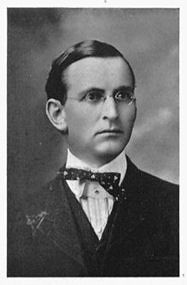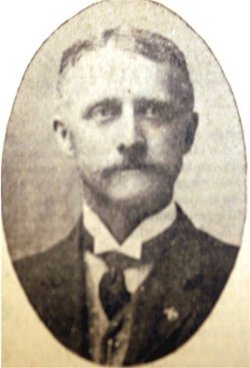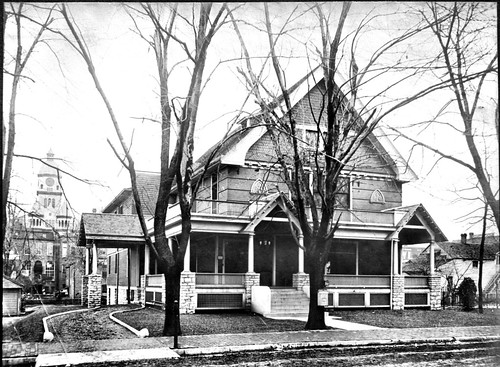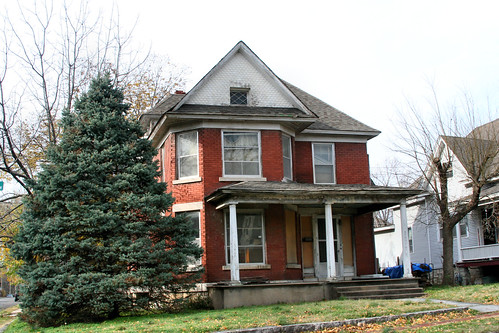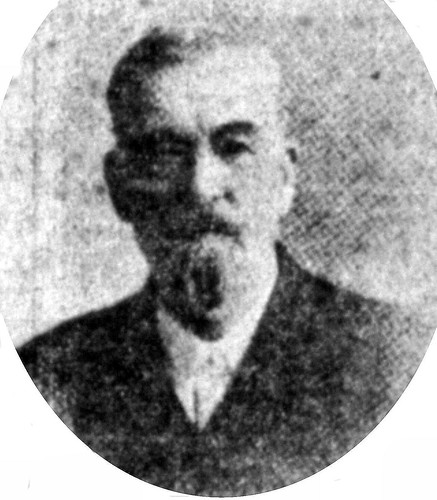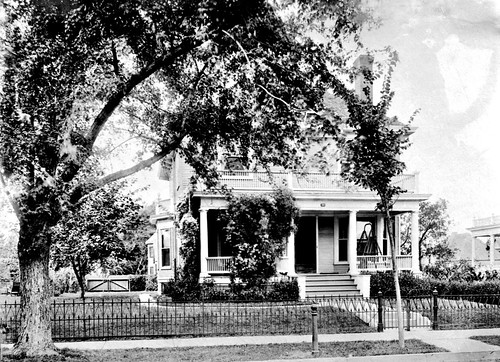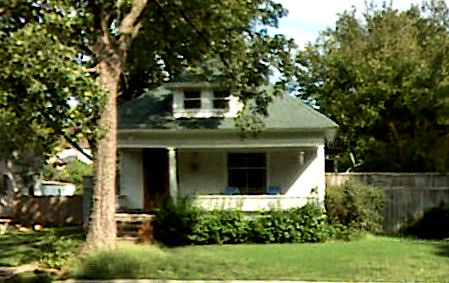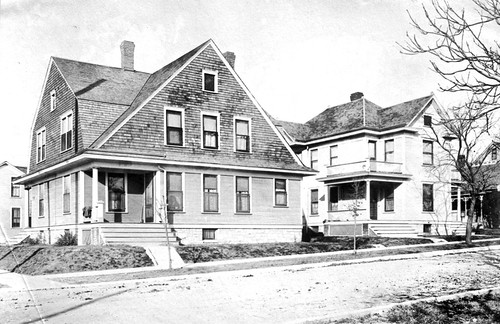
Our next photograph in the Alfred. W. Rea portfolio series is the Blanche Sergeant Double House and Double Flats by Garstang & Rea. Blanche Sergeant was the daughter of Joplin pioneers, Mr. and Mrs. John B. Sergeant. It’s possible that Blanche had the double house and double flats built as an investment, rather than a place to live. While we could not track down the building above, Blanche Sergeant, with her husband attorney Fred Kelsey, eventually moved from Missouri to Los Angeles County, California.
The Architectural Legacy of Garstang & Rea: Blanche Sergeant Double House and Double Flat in Joplin
Joplin Miners: 1910 Western Association Champs
Our next photograph in the Joplin Miners series is the 1910 Joplin Miners.

1910 Joplin Miners: 1) Richard Rohn, 2) Marc Hall, 3) Ralph Bell, 4) George Watson, 5) Bruce Ross, 6) Harry Ellis, 7) Howie Gregory, 8 ) Ed Hawk, 9) W. Burton, 10) Earl Hamilton, 11) Thomas Harlow, 12) Lowthers, 13)Joe Kelly, 14) Bert Lamb.
In 1910, the Joplin Miners finished first in the Western Association and played their games at Cox Baseball Park. Richard Rohn, aka, Dick Rohn, was a hold over from the 1907 team. Ed Hawk, from Exeter, Missouri, made it to the St. Louis Browns in the Majors. While Joe Kelly went on to play for the Pittsburgh Pirates, Chicago Cubs, and the Boston Braves.
The Architectural Legacy of Garstang & Rea: Earnest B. Jacobs House in Carthage, Missouri
The next photograph in our Alfred W. Rea portfolio series is the Earnest B. Jacobs house in Carthage, Missouri. A History of Jasper County, Missouri and Its People, by Joel T. Livingston, has this to say about Mr. Jacobs:
Life is a voyage, in the progress of which we are perpetually changing our scenes. Ernest Jacobs has now arrived at a port where he can stop a while and look back at that part of the voyage he has already successfully made. He has seen the good and the evil that are in the world,–the ups and the downs, and he has learned to be uncensorious, humane. He has learned to attribute the best motives to every action and to be chary of imputing a sweeping and cruel blame. He has no finger of scorn to point at anything under the sun. Along with this pleasant blandness and charity there is a certain grave, serious humor. From this same port he can see an expanse of waters covered with a mist. If there are rocks ahead he cannot see them; if there are whirlpools he hopes to be able to avoid them with the aid of the same pilot that has guided him heretofore and by steering with the same steady hand that has up to this port kept his course straight.
Launched on the sea of life July 20, 1858, in the port of Chicago, Illinois, Ernest B. Jacobs set sail. To leave metaphor for a while, his father, John W. Jacobs was born in New York state in Watertown. He was educated there and studied for the ministry. He entered the Methodist church, his first charge being in his native state. Then he was stationed in Chicago, Illinois, where he was very well known on account of his eloquent oratory and his earnest, conscientious work. While he was still living in New York he married Lucy Young, a native of Ohio. After the death of her husband in Kansas City she went back to New York, where she is living with one of her children.
Ernest B. Jacobs went with his parents from Chicago to Carthage when he was very young. He went to the public and high schools in Carthage. Upon leaving school he taught for a number of years. Although he was a successful teacher, he did not intend to make teaching his life work. In 1877 he was tendered the position of assistant postmaster in Carthage; he accepted the office and held it for eight years, at the end of which time he became associated with the First National Bank of Carthage.
Desiring to learn the banking business thoroughly in all its branches, he started in at the bottom of the ladder, but quickly mounted the rungs until he became cashier. He has held this position for a number of years and is considered one of the veteran financiers of Carthage. During the twenty-six years of his connection with the First National Bank there have been a number of panics, but in that period the bank has never been obliged to borrow a dollar, nor has it been in financial straits at all. He is a director of the banks at Alba, Reeds and LaRussell and it is a significant fact that all three banks have been in a flourishing condition since his connection with them.
In 1884 Ernest B. Jacobs drifted into the matrimonial sea, taking with him Miss Carrie Farwell, belonging to an old Carthage family. The course was steered clear of the breakers which impede the progress of so many sailors in the same sea. They have two children Ernestine, born in Carthage, January 3, 1895, has just (1911) completed her course at the Carthage high school. Jay W. Jacobs, born in Carthage January 7, 1899, is attending the grammar school.
Mr. Jacobs’ connection with the Masons has been a very pleasant one. He is a member of the Carthage Blue Lodge, a Royal Arch Mason, a Knight Templar and a Shriner. He is a member of the Elks Club at Carthage. He is a Republican and by reason of his position and his wide circle of acquaintances is very influential in the political world. Brought up in the Methodist faith, he has continued with the same beliefs. He encourages his wife in her desire for continual self culture and most heartily approves of the literary club of which she is a prominent member. Mr. Jacobs believes that everybody must work and may play; he throws as much enthusiasm into the one as into the other.He is an ardent and successful sportsman. He is a member of the Carter County Hunting & Fishing Club, of the Miami, Oklahoma Hunting & Fishing Club and of the Vernon County Field Club. When he takes a vacation he generally employs it in the indulgence of one or the other of his favorite pastimes, hunting or fishing. Whether in business, the world of sports or private life Mr. Jacobs is very popular and has the confidence of all who know him.
On December 12, 1927, the widowed Earnest Jacobs passed away from a stroke. Upon his death, Knell Mortuary oversaw funeral arrangements. Five years later, in 1932, Knell Mortuary purchased the Jacobs House and has since remained at the corner of West Chestnut and Garrison Avenues.
Architectural Legacy of Garstang & Rea: Elks’ Clubhouse in Carthage, Missouri
Our next photograph in the Alfred W. Rea portfolio series is the Benevolent and Protective Order of Elks clubhouse in Carthage, Missouri. The clubhouse was built in 1901 at an expense of $8,500, or approximately $220,000 in 2010 dollars. The Carthage Lodge No. 529 was founded sometime before 1900 and became defunct sometime before 1947. Presumably, the clubhouse was torn down at some point.
Joplin Miners: 1907
Baseball was an ever present pastime in Joplin, be it amateur or professional. Of the latter, the Miners held Joplin’s attention. In addition to our current series from the portfolio of Alfred W. Rea, we are going to present a short series of four team photographs of the Joplin Miners. Our first is the team from 1907:
1907 Joplin Miners
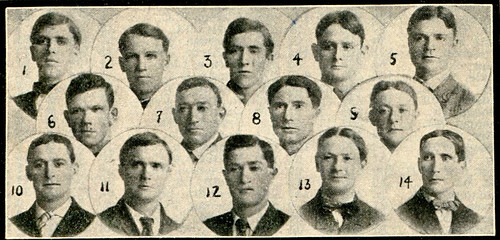
The 1907 Joplin Miners: 1) Owens, 2) Sylvester Oleson, 3) Charles Flemming, 4) Roy Gill, 5) Dick Rohn, 6) Jack Fillman, 7) Tony Vanderhill, 8 ) Manager Louis Armstrong, 9) Guy Harrington, 10) Abner Persch, 11) Conrad Welsch, 12) William George, 13) John Root, 14) Cecil Bankhead.
The 1907 Joplin Miners played at Cox Baseball Park in the Western Association League. Both Vanderhill and Fillman were “veteran” players who had played on previous Miners teams.
The Architectural Legacy of Garstang & Rea: The Leslie W. Winter House of Joplin
Our next entry in the Garstang & Rea series is the Leslie W. Winter house of Joplin at 402 N. Wall. Mr. Winter was a popular fellow and two biographies are found in the tomes of Joplin history. As such, we’ve decided to post both of them here. The first is from A History of Jasper County, Missouri, and Its People, by Joel T. Livingston, which says of Leslie Winter:
Standing forth distinctively as one of the representative and honored citizens of Joplin, Leslie W. Winter, head of the Winter Construction Company, has been a conspicuous figure in developing the mineral resources of this section of the state, and is now busy fulfilling contracts with several large railway corporations, his wisdom and discrimination in the conduct of extensive operations giving him high prestige as a man of affairs. He was born, February 13, 1868, at Cleveland, Ohio, in Cuyahoga county, which was also the birthplace of his father, Malitus C. Winter, and of his Grandfather Winter. He is of thrifty New England ancestry, the branch of the Winter family from which he is descended having been prominent in Massachusetts in colonial times.
Born January 10, 1841, near Cleveland, Malitus C. Winter grew to man’s estate in that vicinity, and subsequently served four years in the Civil war, belonging to an Ohio regiment. He was afterwards there engaged in tilling the soil until 1870, when he moved to Elk Falls, Kansas, and having acquired title to large tracts of valuable land engaged in farming on an extensive scale. Accumulating considerable wealth as a farmer and stock-raiser, he came with his family to Jasper county, Missouri, and has since lived retired from active business in Joplin, being a highly respected citizen of his community. He married Nettie Johnson, who was born at Rock Island, Illinois, where her parents were pioneer settlers.
Brought up in Kansas, Leslie W. Winter was educated in the public schools of Douglass. Making his first appearance in Joplin, Missouri, in 1884, then a beardless boy of sixteen years, he began mining on his own account, the mineral deposits of lead and zinc giving him a rich field of labor, and in addition to looking after his own affairs, he soon began managing mines for others. He opened several good mines, in the meantime establishing a good reputation for expert work and accurate knowledge concerning the location and value of minerals.
Subsequently, having obtained recognition as a dominant power in the operation of large holdings, Mr. Winter was made superintendent of the Old Colony Zinc & Smelting Company properties, which was organized in Boston, Massachusetts, in 1899, by some of the most conservative and reliable business men of that and neighboring cities for the purpose of developing the mineral resources of southeastern Missouri. These men gave their personal attention to the affairs of the company, which included among its officers and directors Col. Albert Clarke, Elias J. Bliss, and George W. Parker, of Boston, Hon. P. C. Cheney, of Manchester, New Hampshire, Hon. D. Russell Brown, of Providence, Rhode Island, and other men of prominence in mining circles. Among other properties owned by this company was the Yale mine, at Webb City, Missouri, the White Rose, at Galena, Kansas, the Black Jack, and it also had a fee to two hundred and thirty-seven and a half acres upon which it had erected four mills, Mr. Winter having been largely instrumental in securing these mines and mills from the Old Colony Zinc & Smelting Company.
Mr. Winter was not only general manager of these extensive mining properties, but a director, and the secretary of the company. He was likewise secretary of the Joplin Improvement & Construction Company, of which Mr. E. J. Overly was president. Since the formation of the Winter Construction Company, Mr. Winter has carried out some very valuable contracts, and has just now closed a contract with the Kansas City Southern Railway Company, the Atchison, Topeka & Santa Fe Railway Company, and with the Missouri Pacific Railway Company for a large amount of construction work. In addition to holding the presidency of the Winter Construction Company, of Joplin, Mr. Winter is president of a coal and coke company, of Arkansas, and a director of the Federal Trust Company, of St. Louis. He is a sound Republican in politics, ever willing to do all in his power to promote the growth and insure the success of his party, and has served as constable of Joplin, and was deputy sheriff one term. Fraternally he is a member of the Joplin Lodge, Benevolent and Protective Order of Elks, and of Joplin Lodge, Modern Woodmen of America.
Mr. Winter married, August 7, 1892, in Joplin, Ella Coleman, a daughter of William H. Coleman. Mr. Coleman was born and bred in New York City, and as a young man migrated to Kansas. Joining the Union Army at the outbreak of the Civil war, he served as captain of a Kansas company, and at the Battle of Shiloh was severely wounded. After the war, and his recovery from his wound, he served as a member of the Kansas Senate two terms, and was very prominent in public affairs, his ability making him a fit leader for the people of his state. Mr. and Mrs. Winter have one child, Nera, born September 10, 1893, is now attending the Joplin High School.
A man of sterling integrity and worth, conducting all of his transactions by the strictest principles of honor, Mr. Winter has gained the trust and confidence of the business world, and the esteem and good will of his fellowmen. He is fond of all out-door sports, his particular hobby being base ball. He is a lover of good horses, of which he has several, and he and his wife, who is an expert horsewoman, and an easy, graceful rider, take long rides in and around Joplin. Both have hosts of friends, and their beautiful home is a center of social activity.
The second biography comes from The Biographical Record of Jasper County by Malcom G. McGregor, has this to say of the life of Leslie W. Winter:
Honored and respected by all, there is no man in Jasper county who occupies a more enviable position in mining and financial circles than Leslie W. Winter, not alone on account of the brilliant success he has achieved, but also on account of the honorable, straightforward business policy he has ever followed. He possesses untiring energy, is quick of perception, forms his plans readily and is determined in their execution; and his close application to business and his excellent management have brought to him the high degree of prosperity which to-day is his. Since 1884 he has been connected with mining interests in Jasper county, and has done much toward the development of the mineral resources of this portion of the state.
Mr. Winter represents one of the old families of Ohio, his grandfather, his father and himself all having been born in Cuyahoga county, while the ancestry of the family were originally from Massachusetts. The father. M. C. Winter, is now a resident of Joplin. He married Miss Nettie Johnson, a native of Rock Island county, Illinois, where her people were early settlers. Mr. Winter, of this review, has spent the greater part of his life in the west, having become a resident of Elk Falls, Kansas, in the early ’70s. In 1884 he arrived in Jasper county. He was then hardly more than a boy, but he began mining on his own account, and the rich mineral deposits of lead and zinc have since given him a field of labor. He began mining on his own account and also managed several mines for others. He opened some good mines and established a reputation for expert work and accurate knowledge concerning the location and value of minerals.
Mr. Winter has devoted his entire life to this line of work, and his close application and unfaltering determination have enabled him to overcome all difficulties and work his way steadily upward. He is now superintendent of the Old Colony Zinc & Smelting Company, of Boston, Massachusetts, which was organized in 1899, and is operating extensively in the rich mineral fields of southwestern Missouri. It is composed of some of the most conservative and reliable business men of Boston and vicinity, who give their personal attention to the affairs of the company. The following are included in the list of officers and directors: Colonel Albert Clarke, Elias J. Bliss and George W. Parker, of Boston; Hon. P. C. Cheney, of Manchester, New Hampshire; Hon. D. Rnsell Brown, of Providence, Rhode Island; H. P. Stimpson, of Boston; and L. W. Winter, who has been actively engaged in zinc mining in the Joplin district for the past twenty years.
The company owns at Neck City, in this county, one of the most flourishing camps in southwestern Missouri, having the fee to two hundred and thirty-seven and a half acres of land, upon which there are four mills. The company has a shaft seven by fourteen feet and two hundred and eighty-five feet in depth–the deepest in southwestern Missouri. They are drifting at two hundred and eighty feet in excellent ore, and the value of their property is indicated by the statement of George B. Paxton, a mining engineer, who says: “In my opinion it will prove richer than any other similar sized tract in this district,” while P. L. Crossman, who has been drilling in all parts of the district for over thirty years, and who did the drilling on this ground, says: “This is, to the best of my knowledge and information, the greatest discovery of the best continuous body of paying ore ground in this mineral district.”
Ever since its organization the Old Colony Zinc and Smelting Company has paid regular quarterly dividends at the rate of ten per cent per annum. At Webb City the company has a lease on forty lots in the Missouri zinc fields, and are operating the Harvard mine and mill, the mine being one of the best producers in the locality, running forty tons of ore per week. They also own the Yale mine at Webb City, and at Galena, Kansas, have the White Rose mine and mill and ten lots of the Murphy land. They also have the Black Jack mine on land belonging to the South Side Mining Company and all of these mines are in operation.
The company is one of the strongest and is operating among the most extensive in the district. Mr. Winter was largely instrumental in securing these mines and mills and the land, and of the Old Colony Zinc & Smelting Company he is not only general manager but is also a director and the secretary of the company. He is also secretary and treasurer of the Joplin Street Improvement & Construction Company, of which E. J. Overley is president and A. G. Jennings vice-president and general manager. This company now has under construction ninety miles of railroad and has two contracts for constructing sewers in East Joplin that will pay twelve thousand dollars. Their office is in the Bank of Joplin.
Mr. Winter was married in Joplin, in 1892, to Miss Ella Coleman, of this city, but formerly of Topeka, Kansas. She is a daughter of William H. Coleman, who was born in New York City and removed to Kansas at an early day. He was there at the time of the outbreak of the Civil war, and, joining the Union army, he served as captain of a Kansas company. After the war he was for two terms a member of the state senate and was very prominent and influential in public affairs owing to his ability and fitness for leadership. Unto Mr. and Mrs. Winter has been born but one child, Neva, who is now in her eighth year.
The name of Mr. Winter figures prominently in connection with political interests in southwestern Missouri.. He is firm and loyal in his support of Republican principles, and does all in his power to promote the growth and insure the success of the party. He has been chairman of the Republican congressional committee for the fifteenth district and also chairman of the Republican city committee. He served for one term as deputy sheriff of the county and also as constable for two years. Socially he is connected with the Independent Order of Odd Fellows and with the Modern Woodmen of America, and in both organizations he enjoys the high regard of his brethren. The career of Leslie Winter has ever been such as to warrant the trust and confidence of the business world, for he has ever conducted all transactions on the strictest principles of honor and integrity. His devotion to the public good is unquestioned and arises from a sincere interest in the welfare of his fellow men.
We’re also happy to say that the Leslie W. Winter House still stands:
Lee Taylor: Joplin’s First Elected Mayor
The first elected mayor of Joplin was born an Englishman. His name was Lee Taylor and by the time he passed away on December 13, 1917, he had lived a very American life. Taylor was born in 1836 in Manchester, England, one of the world’s great industrial cities. At the age of four, his parents immigrated to the United States and settled in the Jasper County, Missouri. In the frontier state of Missouri, Taylor came of age and was reportedly among one of the first to notice the potential of mining in the region. After the commencement of the Civil War, Taylor traveled to Arkansas and enlisted in the Confederate Army. He served in the 34th Arkansas Infantry, fought at the Battle of Prairie Grove, and reportedly rose to the rank of captain by war’s end.
In Arkansas, Taylor met his wife, and together with a growing family, returned to Joplin around 1870, never to leave again. He became involved with mining and was a mine superintendent when talks began between the village of Joplin (where old East Joplin is now located) and Murphysburg to form a unified city. When Joplin was established in 1873, E.R. Moffett was appointed by the state as the first mayor, and Taylor was a councilman. Shortly thereafter, Taylor ran for the position of Mayor. Heavily supported by East Joplin residents, Taylor narrowly beat Moffett to become Joplin’s first elected mayor.
Taylor resigned before the end of his first term and was replaced by Councilman J.H. McCoy. The reason for his abrupt resignation was one of a business nature as apparently his duties as a mine superintendent were far more time consuming than he originally anticipated. By 1880, Taylor lived at 503 Byers Avenue and remained there until a few short years prior to his death, when the former mayor moved to a farm out in the county. Taylor remained involved with Joplin’s growth. He was one of the first Masons in Joplin and served on the city’s Board of Education in 1890 along with Charles Schifferdecker.
By 1900, Taylor listed himself as a grocery dealer in the U.S. Federal Census, but a decade later, he had moved to just north of Carthage to live the life of a grain farmer. A few weeks before December, 1917, the old veteran and pioneer fell ill. At the age of 80, it was generally believed that Taylor’s constitution was still strong enough to overcome illness. Instead, the old pioneer succumbed to kidney disease, and passed away.
The Architectural Legacy of Garstang & Rea:
Our next featured photo from the portfolio of Alfred W. Rea of Garstang & Rea, is the William Houk House in Joplin. The house was located at 218 Sergeant Ave.
Missouri, Mother of the West, Volume 4, has this to say about William Houk, its owner:
William Houk, who died February 26, 1927, had been a resident of Joplin over a quarter of a century. He was one of the prominent figures in the mining development of Southwest Missouri, and was also a very successful financier, being president from its organization of the Conqueror Trust Company.
Mr. Houk was born at Dayton, Ohio, January 20, 1859. His boyhood and early youth were spent in comparative obscurity and poverty, and he was put to many resources and devices to realize his ambitions. When he was a small boy his father died, and he was assisted his mother on the farm. After exhausting the advantages of the rural local schools he attended a normal school, earning and paying his own way. He also took a business college course and subsequently graduated from the Cincinnati Law School. He had two years of experience as a teacher, became bookkeeper for a Cincinnati firm, and for two years practiced law. He was engaged in commercial work at Cincinnati from 1889 until 1900, when he came to Southwest Missouri. He first located at Neosho, where he engaged in numerous mining ventures, and from there removed to Joplin in 1901. He was the responsible factor in developing the Jack Rose, Cardinal and Monitor mines. His mining interests in 1903 were consolidated under the name Conqueror Zinc Companies, which became one of the most prosperous organizations in the Southwest.
The Conqueror Trust Company was organized at the home of Mr. Houk early in 1905, and he served continuously as president until his death. This institution under his active management attained resources of upwards of six million dollars. Mr. Houk owned extensive real estate interests and was a director of the Joplin Marble Quarries Company and the Minden Coal Company, was a stockholder in the Joplin Globe Publishing Company and in other corporations.
The late Mr. Houk was a man of fine taste and cultivated mind. He had been an extensive traveler. He was active in the Rotary Club, and was one of the organizers and the first president of the Joplin Civic Music Club. Mr. Houk’s first wife, Mrs. Edna C. Houk, died in June, 1911, and the one child by this marriage, Helen, died in 1912, at the age of sixteen. Subsequently Mr. Houk married Frances R. Hengelsberg, of St. Louis. Mrs. Houk and two daughters survive him. The elder daughter, Emily, is a student at Wellesley College, Wellesley, Massachusetts, while Edna, the younger daughter, is a junior at Highland Hall, Hollidaysburg, Pennsylvania.
The Architectural Legacy of Garstang & Rea: The B.B. Johnson House of Joplin
Today’s featured Garstang & Rea house is the B.B. Johnson residence located at 417 N. Byers Avenue. Although the house still exists today, the paint color has changed, and there is much more vegetation surrounding it. We are happy to see that yet another Garstang & Rea creation has survived.
(Special thanks to Leslie Simpson, Director of the Post-Memorial Art Reference Library, for tracking down the B.B. Johnson house today!)
The Architectural Legacy of Garstang & Rea: The John H. Cape House in Joplin
Today’s continuation of the Alfred W. Rea portfolio is the John H. Cape House in Joplin, Missouri. Cape commissioned the firm of Garstang & Rea to design his residence. After 1910, Cape and his wife Anna moved west to Colorado Springs, Colorado, where he died in 1914. The Biographical Record of Jasper County, Missouri by Malcolm G. McGregor, has this to say about Cape:
John H. Cape, who since 1886 has been a resident of Joplin and has been actively associated with mining interests, is a native of southeastern Missouri, his birth having occurred near Desota. His people were pioneers of that portion of the state and took an active part in its development and upbuilding, reclaiming its wild lands for purposes of civilization.
The boyhood days of our subject were quietly passed. He had some duties to perform and in the school-room he passed a portion of his time and also enjoyed the pleasures of the playground. Since entering upon his business career he has worked his way steadily upward, overcoming all difficulties and obstacles in his path by determined purpose and energy. He has been connected with the St. Louis Ore & Steel Company and the St. Joseph Lead Company, acting as superintendent of both through a considerable period. In 1886 he came to Joplin and acted as superintendent for different companies, and since 1900 has superintended the Royal Blue mine on the Granby land and the Imperial mine on the Continental land.
These mines were opened in 1896 and the former was known as Blakny No. 2 and the latter as the Lead Mule mine. Before the present company was incorporated he was in the service of the Luther Company, controlling the Lead Mule mine. Since first assuming control of these mines Mr. Cape has remained in continuous charge, superintending their operation, and he also operates two mines ,on his own account, one of which is the Jackson, Jr. He is also engaged in prospecting to a considerable extent, and has done much to develop the mineral resources of the county and thus add to the general prosperity of the stockholders. He is well qualified for his present position, for long study and experience have enabled him to quickly recognize the possibilities of ore, the quality of the metal and what it will produce.
The lady who now bears the name of Mrs. Cape was Miss Anna Grace in her maidenhood, a daughter of Thomas J. Grace, a pioneer settler of Chariton county, Missouri, where occurred the birth of Mrs. Cape, who is a most estimable lady, and with her husband enjoys the high regard of many friends. This union has resulted in the birth of one daughter, Marvel A. He is a Mason and belongs to the blue lodge, chapter and council, and in his life he exemplifies the beneficent and helpful spirit of the fraternity.
The fate of Cape’s cottage is a mystery. According to one city directory, in 1905-1906, Cape lived at 101 N. Byers, but by 1910, resided at 410 Moffet Avenue. An examination of the existing addresses reveals no homes that match the exact appearance of the cottage, though, the Byers address reveals a new house which may have been built in the same location. Do you recognize the cottage? Do you know its fate?

